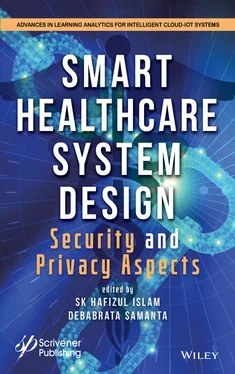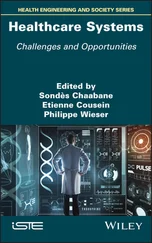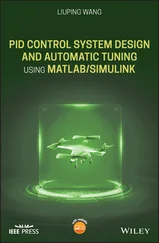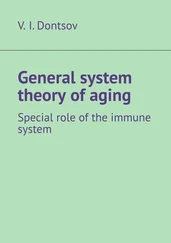Chapter 9discusses the gradually increasing usage of smart devices in various domains, with a particular focus on fusing the IoT into the medical sector to enhance clinical consideration based on the patient. Maintaining the protection of the information generated and obtained by IoT devices is the most severe problem in administering medical services, so the main objective of this chapter is to establish a system for safeguarding the IoT data developed in medical services. Security mechanisms used in the IoT setting must also communicate from end to end and must be adopted by low-cost IoT devices.
Chapter 10explores why the energy consumption of WSNs and IoT devices is considered to be the aggregation and transmission of data. In processing and transmitting redundant and unnecessary data, these devices waste their power. Therefore, this chapter presents a means of eliminating redundant data and reducing the number of data transmissions, thus reducing the energy consumption of the IoT devices. Also included is an end-user remote monitoring system that monitors and verifies performance during real-time communication of these smart objects.
Chapter 11explores the stability, data storage, and performance of various IoT devices that reflect the disadvantages of integrating these kinds of tools in the business sector. Data on the cloud server is more often than not compromised, and data storage is inefficient due to the growing number of users and devices on the internet. However, as new ways of using the IoT are taking shape, these disadvantages must be rectified. The world awaits many developments in the coming decades that will gracefully upgrade current systems; for instance, the advent of edge computing will transubstantiate cloud computing by eliminating technicalities while retaining the appropriate use of bandwidth for data privacy. Besides which, the IoT is bound to change industries, healthcare, traffic control, cyber-security, etc. With its success and steady progress, the future of the IoT is auspicious, with the intent of paving a new path for technological growth. This chapter’s focus is on current IoT developments, their drawbacks, and the potential for future advances.
Chapter 12discusses the use of artificial intelligence (AI) to make machines learn from the environment and make them capable of completing tasks, which helps to optimize their goals. AI, which has subfields such as machine learning, deep learning, and others, is interdisciplinary. Machine learning, which allows computers to automatically learn from their experience, may be achieved with computer programs that access and use them to understand. Deep learning is a subfield of machine learning, which processes or filters knowledge in the same way as the human brain. Here, to predict and classify the content, it uses a computer model that takes the input and filters it through various layers. These areas, such as artificial intelligence, machine learning, and deep learning, have made several developments in technology that have given the world a whole new dimension in each area.
Chapter 13summarizes the important roles of certain AI-driven techniques (machine learning, deep learning, etc.) and AI-enabled imaging techniques for the study, prediction, and diagnosis of COVID-19 disease. Through social networking knowledge, the combined effort of powerful AI and image processing techniques can predict the initial trend of COVID-19 disease, identifying the most affected areas in each country, and predicting drug-protein interactions for the development of new drug vaccines. AI-empowered X-ray and computed tomography image acquisition and segmentation methods, however, help classify and diagnose patients minimally affected by COVID-19. This chapter also addresses an important set of open problems and future research concerns about AI-empowered COVID-19 handling procedures.
Chapter 14mainly deals with the design of a machine learning model for the study of the transmission dynamics of COVID-19, a disease which is affecting the entire world. Ventilated patients with extreme acute respiratory distress being treated while quarantined in the ICU often face difficulties with their most basic human interactions, including communication, due to the respiratory disease, language issues or intubation. There are significant physical and psychological consequences to the inability of ICU patients to communicate. Researchers have created various types of software programs, such as Speech-Language Pathologist, in order to provide both health practitioners and caregivers with augmentative and complementary communication assistance.
SK Hafizul IslamDepartment of Computer Science and Engineering Indian Institute of Information Technology Kalyani West Bengal, India Email: hafi786@gmail.com
Debabrata SamantaDepartment of Computer Science CHRIST (Deemed to be University) Bengaluru, Karnataka Email: debabrata.samanta369@gmail.com May 2021
It is with great pleasure that we express our sincere gratitude and appreciation for all those who significantly helped in the completion of this book with their contributions and support. We are sincerely thankful to Dr. G. P. Biswas, Professor, Department of Computer Science and Engineering, Indian Institute of Technology (Indian School of Mines), Dhanbad, Jharkhand, India, for his encouragement, support, guidance, advice, and suggestions towards the completion of this book. Our sincere thanks to Dr. Siddhartha Bhattacharyya, Professor, Department of Computer Science and Engineering, CHRIST (Deemed to be University), Bengaluru, Karnataka, India, and Dr. Arup Kumar Pal, Assistant Professor, Department of Computer Science and Engineering, Indian Institute of Technology (Indian School of Mines), Dhanbad, Jharkhand, India, for their continuous support, advice and cordial guidance from the very beginning to the completion of this book.
We would also like to express our honest appreciation to our colleagues at the Indian Institute of Information Technology Kalyani, and CHRIST (Deemed to be University), Bengaluru, Karnataka, India, for their guidance and support.
We must also thank the series editors, Dr. Souvik Pal and Dr. Dac Nhuong Le, for accepting our proposal and also for their valuable suggestions for shaping this book.
We also thank all the authors who have contributed chapters to this book, which would not have been possible without their contributions. We are also very thankful to those who reviewed the chapters of the book, whose continuous support and commitment made it possible to complete the chapter reviews on time. We are very grateful to the entire publishing team at Scrivener Publishing, who extended their kind cooperation, timely response, expert comments, and guidance. Finally, we sincerely express our special and heartfelt respect and gratitude to our family members and parents for their endless support and blessings.
1
Machine Learning Technologies in IoT EEG-Based Healthcare Prediction
Karthikeyan M.P.1*, Krishnaveni K.2 and Muthumani N.3
1 Department of Computer Science, PPG College of Arts and Science, Coimbatore, India
2 Department of Computer Science, Sri Ramasamy Naidu Memorial College, Sattur, India
3 PPG College of Arts and Science, Coimbatore, India
Abstract
The classification of medical data is the demanding challenge to be addressed among all research issues since it provides a larger business value in any analytics environment. Medical data classification is a mechanism that labels data enabling economical and effective performance in valuable analysis. Proposed research has indicated that the quality of the features may cause a backlash to the classification performance. Also squeezing the classification model with entire raw features can create a bottleneck to the classification performance. Thus, there is necessity for selecting appropriate features for training the classifier. In this proposed, a system is proposed that can use multiple channel real-time EEG signals to predict the onset of an epileptic seizure. The system is given a select number of EEG channels as input and reports back the corresponding epileptic seizure state at every second and the Hybrid Artificial Neural Network with Support Vector Machine (HANNSVM) based classifications are done as a simulation of real-time dynamic predictions and are dependent upon past predictions that were made. As a result, the sensitivity must be controlled such that seizures aren’t predicted more often than they actually occur. Statistical analysis of accuracy values and computational time portrays that the proposed schemes provide compromising results over existent methods.
Читать дальше












